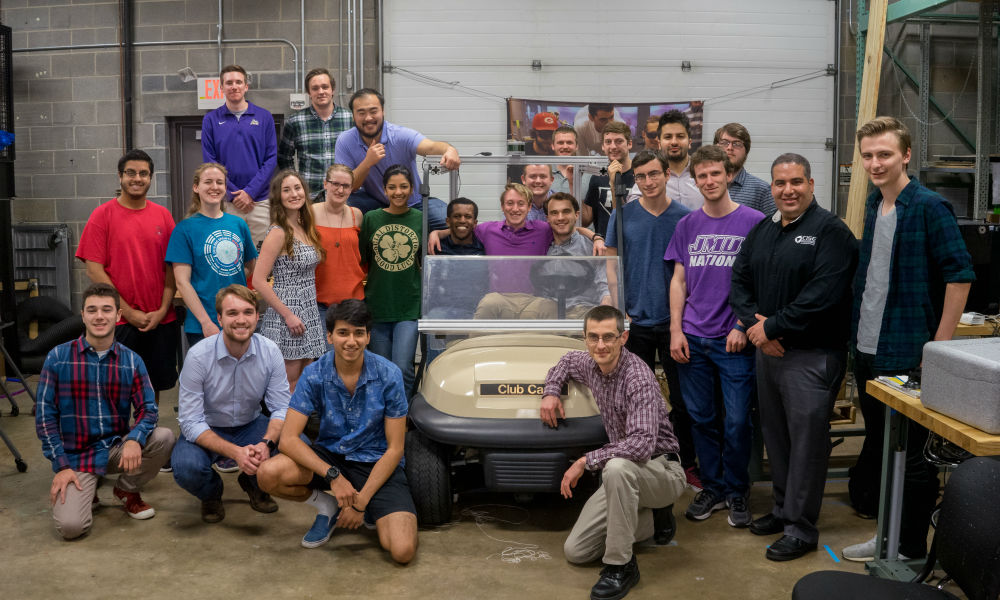Hard work pays off for JMU students and faculty
Autonomous Vehicle Class wins the 2018 Governor’s Technology Award
College of Integrated Science and Engineering
SUMMARY: Efforts pay off for students from across the College of Integrated Science and Engineering (CISE) who teamed with other majors on campus to build an autonomous vehicle.
By Caleb Ayers
Twenty-two students from Computer Science (CS), Integrated Science and Technology (ISAT), Engineering, and Political Science participated in an autonomous vehicle class in the spring of 2018. With collaborative, creative problem-solving and a lot of hard work, they converted a traditional golf cart into one that could operate autonomously in pre-mapped locations with the push of a button on the student-designed website and app.
The project was proposed by Richard Xu (’18) and offered under the auspices of JMU X-Labs, an innovation hub on campus that encourages and facilitates cross-disciplinary studies where students address real-world problems. On the first day of class, under the direction of computer science professor Nathan Sprague and integrated science and technology professor, Samy El-Tawab the students divided themselves into five teams, each of which had specific, interconnected goals and responsibilities. The sensing/processing team installed sensors that could detect obstacles and objects in the route, while the mapping team focused on path-planning and the car’s decision-making process. The motor team modified the mechanical parts of the car and made the necessary physical adjustments for the vehicle to work, while the front-end team was responsible for the user interface—the
Students spent the semester brainstorming, collaborating and experimenting. They designed the car to use lidar—a detection system similar to radar that uses lasers to provide 3D information about the surrounding area. Using a JMU parking lot as the students’ primary mapping location and the application programming interface from Google Maps, the car was able to monitor its location and navigate within the map. With sensors that the team installed, the car could also detect and respond to obstacles along the routes it chose.
Dr. El-Tawab acknowledged the interconnectedness of the teams involved, “This is exactly how a multi-team real-world project works,” he said. “One team depends on the other team’s work, so if any team fails, the whole project fails”
Professor Sprague noted that having a variety of specialties wasn’t just a bonus; it was the crux of the project. The engineers brought an understanding of mechanics and electronics, which they used to modify the golf car and the political science major handled the legal and policy issues involved with operating the vehicle on campus. The computer scientists used their knowledge to design systems that could process the sensor data, make driving decisions, and interface with the Google Maps API while the ISAT students provided project management, leadership, and networking. “It wouldn’t have been possible without bringing in expertise from all of those different disciplines,” said Sprague.
Claire Fulk (’18), the project management team lead, agreed that having experts in different areas is what allowed the success of the project. “It was almost like bringing in specialists from different fields, which is exactly what would be done in the real world,” she said.
Jordan Domsky (‘18), the team lead for planning and navigation, appreciated the atypical, experiential nature of this class. “[The professors] didn’t know how to solve this problem either,” he said. “It’s not like a normal class where you say, ‘What’s the answer and how do I get it.’ ”
Each semester, this innovative course will change premise to focus on improving the system and abilities of the car that’s already in place. Each iteration of the course will build upon the success of the teams that have gone before them.
“In CISE we focus on real-world problems without clear solutions. Projects like the self-driving golf cart give our undergraduate students the chance to wrestle with a challenge that could have a variety of solutions,” said Bob Kolvoord, Dean of the College of Integrated Science and Engineering. “The Governor’s Technology Award granted for this work is recognition that our students and faculty are making a difference.”
The awards were presented Wednesday, Sept. 5, in Richmond during the annual Commonwealth of Virginia Innovative Technology Symposium.
